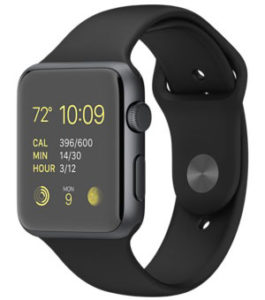
I recently heard an amazing story about how an Apple shop had dumped Apple for Dell. Over most of the last two decades, the only time I’ve seen a move like this was when some change in IT forced it, and a lot of staffers subsequently would quit as a result. This move was largely user-driven.
Then, last week, the WSJ came out and actually panned an Apple product, effectively calling it pretty but stupid (historically the WSJ has been one of Apple’s biggest fans).
Finally, the reviews on the new Apple Watch prior to its release were decidedly mixed, even though the product was wrapped with one of the better marketing campaigns I’ve seen of late.
Apple’s margins are held up by the perception that its products are worth the extra money, but that could be shifting due to a perception that Apple is taking advantage of users.
I’ll dig deeper into that this week and close with my product of the week: the best damned security camera I’ve so far found for the home, the Flir FX.
Apple’s Consumer Perceptions
The WSJjust panned the new Apple MacBook — basically concluding it was a pretty, but way too expensive, netbook.
Apple pretty much owned reviews at the WSJ when Walt Mossberg worked there, and Walt left the paper around the time that Steve Jobs passed. One of the ways Apple, under Jobs, ensured positive initial reactions was by providing high-profile reviewers with advance access to hardware. Those early hands-on reviews were popular and drove publication sales, so there was a disincentive to go negative and possibly be cut out of the loop next time around.
If that should happen, competitors would then get those scoops — and the readers who went with them. Well Mossberg is gone from the WSJ, and suddenly it is panning Apple products. Apple carries massive margins, and there always has been a chance that buyers could become convinced that Apple was taking advantage of them.
The Apple Watch reviews showcase how badly this structure has been damaged. Instead of the early reviewers being virtually all glowingly positive, the reviews have been decidedly mixed, with an impressive number of reviewers concluding they couldn’t pay for most of the watches.
If Apple no longer can control the initial perception of its products, then it drifts down to where virtually all other companies live — in a mass of mixed reviews often more focused on the product’s problems than its intangible magic. It is that intangible magic that gets people to pay Apple its mammoth profits.
Dell/Apple and Business Perceptions
The story involving Dell is what got me thinking about this. At the heart of it was an Apple shop, Sparksight, that makes short movies. It had become a loyal Apple shop years ago. Dell was so proud of its new workstations that it (foolishly, I might argue, because of the likely chance it could publicly backfire) provided one of its workstations to test against the Apple Mac Pros Sparksight was using.
Typically, Sparksight builds a film during the week and then has it rendered over the weekend, because the rendering takes upwards of eight hours. Some poor sap has to come in over the weekend and restart the process if the rendering effort fails, sometimes repeatedly. Sparksight recently had moved off Final Cut Pro, because version 10 had shifted more toward a consumer offering and no longer was competitive. It therefore had gone back to Adobe.
Well Dell got the dreaded call shortly after the test concluded and was told its new workstation was crap, because it had crashed in minutes. The Dell folks were suitably embarrassed and sent support folks to figure out why, and they discovered that the workstation hadn’t crashed at all. It had completed the job in a small fraction of the time the Apple products had required. It was so much faster, it was literally unbelievable.
Sparksight is now in the process of becoming a Dell shop (there is a video up of Sparksight made a video singing Dell’s praises).
The point to take away is that the company was so sure Apple was better that it took someone from the outside coming in to prove that wasn’t the case — even though the evidence was clear. Such is the power of perception, but Dell is now using this as a lever to show other Apple accounts that their Apple workstations are crap — and that being blind to that reality is hurting their bottom line.
Sparksight itself says it best: “The processing power you get per dollar with Dell is twice what you’d get from a Mac. For some people, their heart might be with Mac but we have to run our business with our head. As we budget for more hardware, it will be Dell.”
Apple had a huge advantage in the workstation market. Unlike other hardware manufacturers, it didn’t have to get its products certified by the software vendors first. I imagine that annoyed the hell out of the software vendors and clearly pissed off competitors like Dell. When Apple brought out Final Cut Pro, it certainly annoyed the heck out of Adobe, in particular.
So I expect this mammoth performance advantage is likely as much about Adobe sticking it to Apple as it is about Dell’s workstation advancements. Though, since it has gone private, Dell has dropped millions more into R&D that otherwise would have been spent on stock buybacks, compliance, or keeping Carl Icahn happy, suggesting there is considerable technical special sauce in this solution as well.
In the end, this suggests that Apple’s free certification ride may be over. Unless it can close this performance gap, it will be forced out of the animation and special effects segment — that means operating units and companies like Pixar, Lucas, and Disney.
Steve Jobs is likely to come back from the dead and slap Tim Cook around if that happens, and Walt Disney might chip in and help. Then again, knowing Disney, he might be more proud that his people also are thinking with their heads.
Wrapping Up: Changing Perceptions
Coming into the launch of the Apple Watch was the perception that Apple couldn’t fail, but with the early reviews of the MacBook and Watch spinning negative, there is a good chance that perception will be broken in the next few weeks.
Apple appears to be losing a good chunk of its workstation vendors, because it appears to have fallen incredibly far behind in performance there. Folks who don’t like Apple may be cheering at the moment — but remember, Apple is a major bellwether in the stock market now. If its valuation collapses, it likely will take a number of firms with it.
That’s something to think about if it doesn’t quickly get the perceptions surrounding new Apple products back in order. We could all feel Apple’s pain.
At the heart of this are three things: an imbalance between design and engineering, which is sacrificing too much functionality for looks; a collapse of Apple’s loyal reviewer base — many have moved on, like David Pogue to Yahoo and Walt Mossberg to All Things D); and an inability to do the thing Jobs perhaps did best, which was to create the special magical perception surrounding its new products.
Apple is breaking, not on what Cook does best, but on what Jobs did best. This is still showcasing that Jobs’ ability to control perception is currently an unmet need in Apple and more than just Apple fans will care about this if the market starts to see just how far Apple has fallen.
Crime is a bit out of control in Silicon Valley — either that or we have, through services like Nextdoor, become far more aware of what is going on around us. It seems like every week now, someone is having their car stolen or home broken into, and the burglars are increasingly getting really creative — like pretending they are from PG&E. There now apparently are groups of folks who follow UPS and FedEx trucks to take packages when they are dropped off at front doors.
More and more often, my neighbors are buying and using security cameras, but the images produced aren’t sharp enough to see license plates — or the cameras just aren’t working when the theft occurs. Setting these things up so they actually work isn’t trivial.
Well, I may have the answer. Flir, a firm mostly known for industrial and military infrared cameras and scopes, last week launched the Flir FX. It uses as a back end the same kind of technology that was used to catch the Boston Marathon Bomber, in that it can overlay a huge number of videos so you can find in minutes the exact time when the event you want to look at was seen by the camera.

It has a back-up battery that keeps it recording even if you lose power, and it has on-board storage so that if the network goes down, the image won’t be lost — and it sends what it captured to the cloud once power is restored.
Given the onboard power and memory, you actually can use this like you would a GoPro, and coming soon are accessories that will protect and mount it. That said, taking your security camera with you to tape what you are doing kind of defeats the purpose of catching what is going on at home while you are gone.
At a starting price of US$200 for indoor use and $249 for outdoor use (water resistant case and better lights) it isn’t a bad deal for what you get — a camera you can depend on that is backed with software that actually seems to do the job. Because it will keep me safer, the Flir FX is my product of the week.
























































